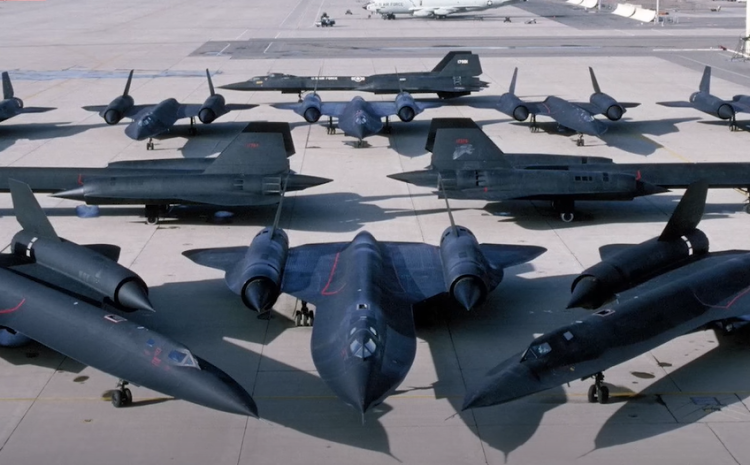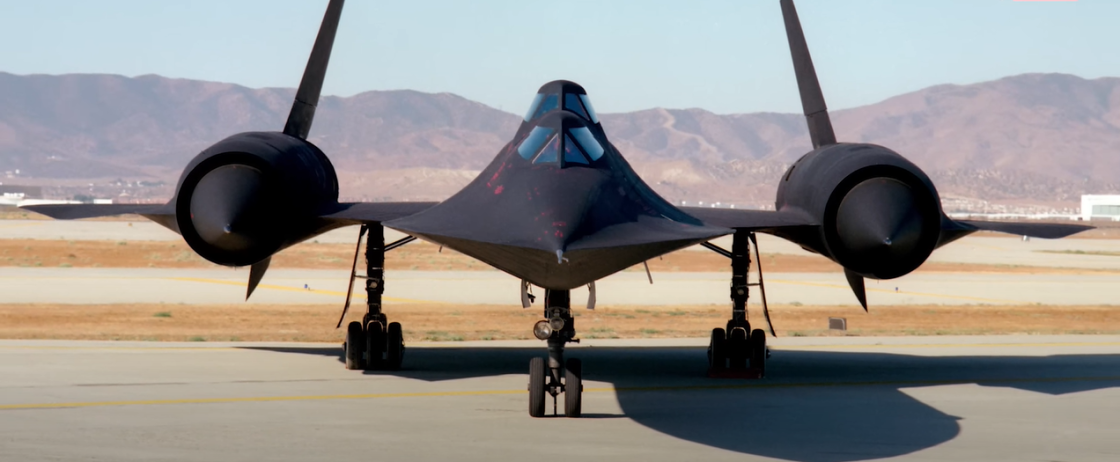A Deep Dive Into the Surviving SR-71 Blackbirds

In the midst of the Cold War, a remarkable creation emerged – the SR-71 Blackbird, a marvel of engineering born out of sheer necessity. Developed from the A-12 OXCART and YF-12 aircraft programs, its primary objective was to serve as a strategic reconnaissance aircraft, surpassing and outmaneuvering potential threats.
The mastermind behind this extraordinary aircraft was Kelly Johnson, the renowned engineer from Lockheed Martin’s Skunk Works division. Taking its inaugural flight in 1964, the SR-71 possessed the exceptional ability to perform Mach 3+ speeds and operate at altitudes exceeding 85,000 feet.
The design of the SR-71 was an engineering triumph, constructed predominantly from titanium and a radar-absorbing composite material, rendering it surprisingly stealthy for its era. However, the intense air friction during flight subjected a significant portion of the Blackbird’s surface to temperatures exceeding 500 degrees Fahrenheit, necessitating ingenious solutions for heat expansion and fuel sealing.
Equipped with state-of-the-art cameras and sensors, the SR-71 excelled at capturing high-resolution imagery and data while soaring at immense speeds and altitudes. Safely nestled within international airspace, these systems allowed the Blackbird to conduct surveillance on enemy territories, thus becoming an invaluable asset for intelligence gathering.
Operational History: The SR-71 in Action
The SR-71, a cutting-edge strategic reconnaissance aircraft, played a crucial role in the United States’ surveillance operations from 1966 to 1998. Throughout its operational history, the Blackbird was deployed on numerous reconnaissance missions over various potential adversaries worldwide, including the Soviet Union, North Vietnam, North Korea, and other sensitive locations.
Speed and Altitude
Unmatched Capabilities One of the SR-71’s most remarkable features was its unparalleled speed and altitude capabilities. With a top speed of Mach 3.2 (around 2,455 mph) and a cruising altitude of 85,000 feet, it was virtually invulnerable to most enemy defenses. This high-speed performance allowed the SR-71 to quickly evade threats and outrun missiles.
SR-71 Key Performance Metrics
| Metric | Value |
|---|---|
| Top Speed (Mach) | 3.2 |
| Cruising Altitude | 85,000 feet |
| Maximum Range | 3,682 miles (approx) |
| Length | 107 feet 5 inches |
| Wingspan | 55 feet 7 inches |
Combat Effectiveness
Evading Enemy Fire Despite facing surface-to-air missile threats during reconnaissance missions, the SR-71 managed to avoid being shot down by enemy fire. Its high-speed and high-altitude capabilities enabled the aircraft to outmaneuver incoming missiles effectively. When targeted, the SR-71 would simply accelerate and climb to a height beyond the missile’s reach, ensuring its safety and mission success.
Tragedies and Losses
Tragedies and Losses Despite its remarkable success and advanced technology, the SR-71’s operational career was not without its share of tragedies. Out of the 32 aircraft constructed, 12 were lost to accidents over the years. Operating the Blackbird at extreme speeds and altitudes presented inherent dangers, and combined with the aircraft’s finicky maintenance requirements and operational quirks, these factors contributed to the losses.
SR-71 Accidents and Losses
| Serial Number | Date of Loss | Location | Reason for Loss |
|---|---|---|---|
| 61-7953 | Jan 25, 1966 | Edwards AFB, California | Tire failure during takeoff |
| 61-7963 | Jun 15, 1971 | Near Mt. Iliamna, AK | In-flight breakup due to structural failure |
| 61-7971 | Jul 17, 1972 | Kadena AB, Okinawa | Engine explosion during takeoff |
The Remaining Blackbirds: A Detailed Analysis

Despite these losses, 20 SR-71 Blackbirds survive today, standing as a testament to a remarkable period in military aviation history. These aircraft are scattered across various museums and air bases in the United States, with one residing in the Imperial War Museum Duxford in England. Let’s dive into a detailed analysis of each of these surviving Blackbirds.
- National Air and Space Museum, Washington, D.C.: The National Air and Space Museum is home to SR-71 serial number 61-7972. This aircraft has the distinction of making the final SR-71 flight in 1990, breaking four speed records en route from Los Angeles to Washington, D.C. This Blackbird accumulated over 2,800 hours of flight time and completed 942 total sorties during its operational life;
- Steven F. Udvar-Hazy Center, Virginia: The Udvar-Hazy Center houses SR-71 serial number 61-7980. This particular Blackbird holds the record for the most flight hours of any SR-71 at 2,981.1 hours. It was also the last SR-71 to fly under NASA control;
- The Museum of Flight, Seattle: This museum features the only surviving M-21 variant, serial number 60-6940. The M-21 was a unique model designed to launch the D-21 drone, a pilotless, faster version of the Blackbird intended for high-risk reconnaissance missions. Only two M-21s were ever made;
- Pima Air and Space Museum, Arizona: The SR-71 at this museum, serial number 61-7951, flew more operational missions than any other Blackbird. This aircraft logged over 3,500 hours of flight time and completed over 1,000 sorties during its service;
- The remaining Blackbirds reside in various locations, including the Strategic Air Command & Aerospace Museum in Nebraska, the March Field Air Museum in California, the Southern Museum of Flight in Alabama, and the U.S. Space & Rocket Center in Alabama, among others.
Technological Impact: The Legacy of the SR-71

The SR-71 Blackbird’s impact on aviation technology continues to resonate, leaving an enduring legacy even in retirement. This remarkable aircraft pushed the boundaries of what was considered technologically possible during its operational years, and its influence can be seen in various fields, including materials science, aerodynamics, engine design, and surveillance systems.
Advancements in Materials Science
The SR-71’s ability to reach unprecedented speeds necessitated the use of innovative materials to withstand the extreme heat generated by friction with the air at high velocities. Engineers turned to advanced materials like titanium alloys to construct the aircraft’s airframe, which allowed it to endure temperatures of up to 600 degrees Celsius (1112 degrees Fahrenheit) during flight. The development and application of these materials have since influenced the design of other high-speed and high-temperature aircraft.
SR-71 Materials Advancements
| Area of Advancement | Description |
|---|---|
| Airframe Construction | Use of titanium alloys to withstand high temperatures |
| Thermal Protection | Advanced thermal tiles for heat management |
| Stealth Technology | Lessons for radar-evading design |
Aerodynamics and Design Innovations
The SR-71’s sleek and streamlined design significantly contributed to its unmatched speed and performance. Engineers meticulously designed the aircraft’s shape to minimize drag and optimize its aerodynamic efficiency. The unique “chined” fuselage, where the curved upper and lower surfaces meet at a sharp angle, was one such innovation that helped reduce wave drag. The knowledge gained from the SR-71’s aerodynamic studies has influenced the development of subsequent aircraft, particularly those intended for high-speed flight.
Advancements in Engine Technology
The SR-71 relied on powerful Pratt & Whitney J58 engines that operated on a unique “turbojet-ramjet” principle. These engines could switch between turbojet mode for subsonic speeds and ramjet mode for supersonic and hypersonic flight. The technology developed for the SR-71’s engines paved the way for advancements in propulsion systems, especially in hypersonic flight research.
SR-71 Engine Technology Advancements
| Area of Advancement | Description |
|---|---|
| Turbojet-Ramjet Technology | Switchable engine modes for different flight speeds |
| High-Thrust Engines | Increased power for high-speed flight |
Surveillance Systems and Reconnaissance
The SR-71 was primarily a reconnaissance aircraft, and its advanced surveillance systems enabled it to gather critical intelligence over hostile territories. Its ability to fly at high altitudes and incredible speeds allowed it to swiftly cover vast areas, capturing valuable information. The intelligence gathered by the SR-71 played a significant role in shaping strategic decisions during the Cold War and beyond.
The SR-72: Continuing the Legacy
The SR-71’s legacy lives on in the development of the SR-72, a hypersonic unmanned aircraft being pursued by Lockheed Martin. This next-generation aircraft aims to operate at speeds of up to Mach 6, twice the speed of its predecessor. Drawing inspiration from the SR-71’s groundbreaking technology, the SR-72 represents the next phase of hypersonic flight research and will likely influence future aviation advancements.
SR-72 Key Features
| Feature | Description |
|---|---|
| Hypersonic Capability | Operates at speeds up to Mach 6 |
| Unmanned Aircraft | Autonomous, pilotless operation |
| Advanced Surveillance | State-of-the-art reconnaissance capabilities |
Conclusion
In the annals of American aviation history, one aircraft stands as a powerful symbol—the SR-71 Blackbird. It serves as a testament to the boundless human ingenuity and our relentless pursuit to conquer technological frontiers. Even in modern times, its remarkable capabilities continue to evoke awe and command respect. Whether these remaining SR-71s are on public exhibition or safely held within private collections, they serve as poignant reminders of an era when technology catapulted us forward, forever altering the landscape of military aviation.
FAQ
The U.S. Air Force commissioned a total of 32 SR-71 Blackbirds.
Twelve SR-71 Blackbirds were lost in various accidents. Despite their high-risk missions, none were lost to enemy action.
There are 20 confirmed SR-71 Blackbirds remaining in existence today.
The surviving Blackbirds can be viewed at various museums and air bases in the United States, with one located at the Imperial War Museum Duxford in England.
No, all the remaining SR-71s are retired. They are preserved in museums and serve as symbols of American innovation and engineering prowess.